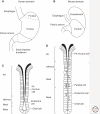Wnt signaling, stem cells, and cancer of the gastrointestinal tract
- PMID: 22474007
- PMCID: PMC3312683
- DOI: 10.1101/cshperspect.a007989
Wnt signaling, stem cells, and cancer of the gastrointestinal tract
Abstract
The Wnt signaling pathway was originally uncovered as one of the prototype developmental signaling cascades in invertebrates as well as in vertebrates. The first indication that Wnt signaling also plays a role in the adult animal came from the study of the intestine of Tcf-4 (Tcf7L2) knockout mice. The gastrointestinal epithelium continuously self-renews over the lifetime of an organism and is, in fact, the most rapidly self-renewing tissue of the mammalian body. Recent studies indicate that Wnt signaling plays a central role in the biology of gastrointestinal stem cells. Furthermore, mutational activation of the Wnt cascade is the principle cause of colon cancer.
Figures



References
-
- Albuquerque C, Breukel C, van der Luijt R, Fidalgo P, Lage P, Slors FJ, Leitao CN, Fodde R, Smits R 2002. The “just-right” signaling model: APC somatic mutations are selected based on a specific level of activation of the β-catenin signaling cascade. Hum Mol Genet 11: 1549–1560 - PubMed
-
- Andreu P, Colnot S, Godard C, Gad S, Chafey P, Niwa-Kawakita M, Laurent-Puig P, Kahn A, Robine S, Perret C, et al. 2005. Crypt-restricted proliferation and commitment to the Paneth cell lineage following Apc loss in the mouse intestine. Development 132: 1443–1451 - PubMed
-
- Baker JD, Truman JW 2002. Mutations in the Drosophila glycoprotein hormone receptor, rickets, eliminate neuropeptide-induced tanning and selectively block a stereotyped behavioral program. J Exp Biol 205: 2555–2565 - PubMed
-
- Barker N, Clevers H 2010. Leucine-rich repeat-containing G-protein-coupled receptors as markers of adult stem cells. Gastroenterology 138: 1681–1696 - PubMed
-
- Barker N, van Es JH, Kuipers J, Kujala P, van den Born M, Cozijnsen M, Haegebarth A, Korving J, Begthel H, Peters PJ, et al. 2007. Identification of stem cells in small intestine and colon by marker gene Lgr5. Nature 449: 1003–1007 - PubMed
MeSH terms
Substances
LinkOut - more resources
Full Text Sources
Other Literature Sources
Medical
